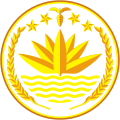Bangladesh
Bangladesh (Bengali: বাংলাদেশ) is a country in South Asia, bordered by India to the west, north, and east, Myanmar to the southeast, and the Bay of Bengal to the south. Known for its rich cultural heritage, natural beauty, and diverse ecosystems, Bangladesh is one of the most densely populated countries in the world[1].
| Bangladesh | |
|---|---|
 |
|
| National Flag of Bangladesh | |
 |
|
| National emblem of Bangladesh | |
| Anthem | আমার সোনার বাংলা (Bengali) |
 |
|
| Map of Bangladesh | |
| Capital | Dhaka |
| Largest City | Dhaka |
| Official Languages | Bengali language, |
| Government Type | Unitary parliamentary republic |
| President | Mohammed Shahabuddin |
| Prime Minister | Muhammad Yunus (acting) |
| Area (km²) | 148,460 |
| Population Estimate | 173,562,364 (2024) |
| GDP (Nominal) | $455.166 billion (34th) |
| GDP per capita | $2,650 (137th) |
| Currency | Taka (৳) (BDT) |
| Timezone | UTC+6 (BST) |
| Drives on | left |
| Calling Code | +880 |
| Internet TLD | .bd .বাংলা |
| Official Website | https://bangladesh.gov.bd |
Etymology
The name "Bangladesh" is derived from the Bengali words "Bangla" (referring to the Bengali language) and "desh," meaning "country" or "land."[2]
History
Bangladesh has a long history that includes being part of ancient kingdoms and empires such as the Maurya and Gupta Empires. The region was later ruled by the Delhi Sultanate and the Mughal Empire, which influenced its culture, religion, and architecture[3].
After British colonization in 1757, Bengal became a crucial part of British India. Following India's partition in 1947, it became East Pakistan, eventually leading to the Bangladesh Liberation War in 1971, which culminated in Bangladesh's independence[4].
Geography
Bangladesh features a primarily flat landscape with numerous rivers, including the Padma (Ganges), Meghna, and Jamuna. This river system plays a vital role in agriculture and the overall economy but also makes the country prone to floods[5].
Climate
The country has a tropical monsoon climate, with a distinct rainy season from June to October. Bangladesh faces seasonal flooding and is also vulnerable to cyclones due to its location near the Bay of Bengal[6].
Demographics
As of 2023, Bangladesh has a population of approximately 165 million people, with the majority identifying as ethnic Bengalis. Other ethnic groups, including indigenous communities, mainly reside in the Chittagong Hill Tracts[7].
Culture
Bangladeshi culture is a blend of ancient Hindu, Buddhist, and Islamic traditions. Festivals like Pohela Boishakh (Bengali New Year) are celebrated by people across religions. The country is also known for its rich literary heritage and Bengali music[8].
Government
Bangladesh is a parliamentary democracy, with the President as the head of state and the Prime Minister as the head of government. It is divided into eight administrative divisions[9].
Economy
The economy of Bangladesh has grown significantly in recent decades, with the garment industry as one of its key sectors. Other important economic activities include agriculture, fishing, and remittances from Bangladeshi workers abroad[10].
References
- ↑ World Bank. "Population density - Bangladesh." Retrieved November 4, 2024.
- ↑ Encyclopædia Britannica. "Bangladesh - Etymology." Retrieved November 4, 2024.
- ↑ Choudhury, Supriya. History of Bengal. Oxford University Press, 2010.
- ↑ Bangladesh Bureau of Statistics. "Historical Overview of Bangladesh's Independence." Retrieved November 4, 2024.
- ↑ World Bank. "Bangladesh Overview." Retrieved November 4, 2024.
- ↑ Climate Data.org. "Climate of Bangladesh." Retrieved November 4, 2024.
- ↑ Minority Rights Group International. "Ethnic Minorities in Bangladesh." Retrieved November 4, 2024.
- ↑ Encyclopædia Britannica. "Bangladesh - Culture and Society." Retrieved November 4, 2024.
- ↑ Encyclopædia Britannica. "Government and Politics in Bangladesh." Retrieved November 4, 2024.
- ↑ World Bank. "Bangladesh Economic Outlook." Retrieved November 4, 2024.

